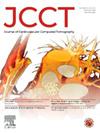The association between peripheral medial and intimal arterial calcification patterns with central arterial stiffness in individuals with type 2 diabetes mellitus: The cross-sectional Early-HFpEF study
IF 5.8
2区 医学
Q1 CARDIAC & CARDIOVASCULAR SYSTEMS
引用次数: 0
Abstract
Background
Animal studies suggest that medial arterial calcification (MAC) increases arterial stiffness, which in turn could lead to cardiovascular disease (CVD), but human studies are lacking. We evaluated the associations of peripheral arterial calcification pattern and quantity with arterial stiffness in individuals with type 2 diabetes mellitus (T2DM).
Methods
Cross-sectional data was used of 774 individuals (64 % men, 67 [63–71] years) with T2DM who underwent carotid-femoral pulse wave velocity measurements (cfPWV) and CT-scans of the lower-extremities. Femoral and crural dominant arterial calcification patterns (MAC, intimal (IAC), absent/indistinguishable) were determined via a histologically-validated scoring algorithm. Calcification Agatston scores were categorized into zero (reference category) and tertiles>0. Multivariable-adjusted linear regression was used.
Results
MAC and IAC were dominant in 38% and 24% of femoral arteries versus 29% and 15% of crural arteries, respectively. Femoral and crural MAC were associated with higher cfPWV (0.64 m/s [0.26–1.03]; 0.76 [0.37–1.14], respectively). Crural but not femoral IAC was associated with higher cfPWV (0.58 [0.10–1.06]; 0.25 [-0.20–0.69], respectively). Adjusted for calcification quantity, only crural MAC remained significantly associated with higher cfPWV. cfPWV was higher in individuals with MAC versus IAC, but not statistically significant (femoral p = 0.066; crural p = 0.490). Femoral and crural calcification scores in the highest tertile were associated with higher cfPWV (0.86 [0.34–1.39]; 0.78 [0.29–1.27], respectively).
Conclusion
Crural MAC was independently associated with increased arterial stiffness. Arterial stiffness was higher in MAC versus IAC. Crural and femoral arterial calcification quantity were associated with increased arterial stiffness. Peripheral arterial calcification, specifically MAC, may lead to CVD via increased arterial stiffness in T2DM.
2型糖尿病患者外周血、内、内膜动脉钙化模式与中枢动脉僵硬度的关系:早期hfpef横断面研究
背景:动物研究表明,内侧动脉钙化(MAC)增加动脉硬度,从而可能导致心血管疾病(CVD),但缺乏人体研究。我们评估了2型糖尿病(T2DM)患者外周动脉钙化模式和数量与动脉僵硬度的关系。方法:774例T2DM患者(64%为男性,67[63-71]岁)接受了颈-股动脉脉波速度测量(cfPWV)和下肢ct扫描的横断面数据。通过组织学验证的评分算法确定股动脉和脚动脉主要钙化模式(MAC,内膜(IAC),缺失/无法区分)。钙化Agatston评分分为0分(参考类)和5分>分。采用多变量调整线性回归。结果:股动脉中MAC和IAC分别占38%和24%,脚动脉中MAC和IAC分别占29%和15%。股骨和脚部MAC与较高的cfPWV相关(0.64 m/s [0.26-1.03];0.76[0.37-1.14])。脚部IAC与cfPWV升高相关,但与股部IAC无关(0.58 [0.10-1.06];分别为0.25[-0.20-0.69])。根据钙化量调整后,只有脚部MAC与较高的cfPWV显著相关。MAC患者cfPWV高于IAC患者,但无统计学意义(股骨p = 0.066;脚部p = 0.490)。最高胎位的股骨和脚钙化评分与较高的cfPWV相关(0.86 [0.34-1.39];0.78[0.29-1.27])。结论:脚部MAC与动脉僵硬度增加独立相关。MAC组动脉僵硬度高于IAC组。脚动脉和股动脉钙化程度与动脉硬度增加有关。外周动脉钙化,特别是MAC,可能通过增加T2DM患者的动脉硬度导致CVD。
本文章由计算机程序翻译,如有差异,请以英文原文为准。
求助全文
约1分钟内获得全文
求助全文
来源期刊

Journal of Cardiovascular Computed Tomography
CARDIAC & CARDIOVASCULAR SYSTEMS-RADIOLOGY, NUCLEAR MEDICINE & MEDICAL IMAGING
CiteScore
7.50
自引率
14.80%
发文量
212
审稿时长
40 days
期刊介绍:
The Journal of Cardiovascular Computed Tomography is a unique peer-review journal that integrates the entire international cardiovascular CT community including cardiologist and radiologists, from basic to clinical academic researchers, to private practitioners, engineers, allied professionals, industry, and trainees, all of whom are vital and interdependent members of our cardiovascular imaging community across the world. The goal of the journal is to advance the field of cardiovascular CT as the leading cardiovascular CT journal, attracting seminal work in the field with rapid and timely dissemination in electronic and print media.
 求助内容:
求助内容: 应助结果提醒方式:
应助结果提醒方式:


